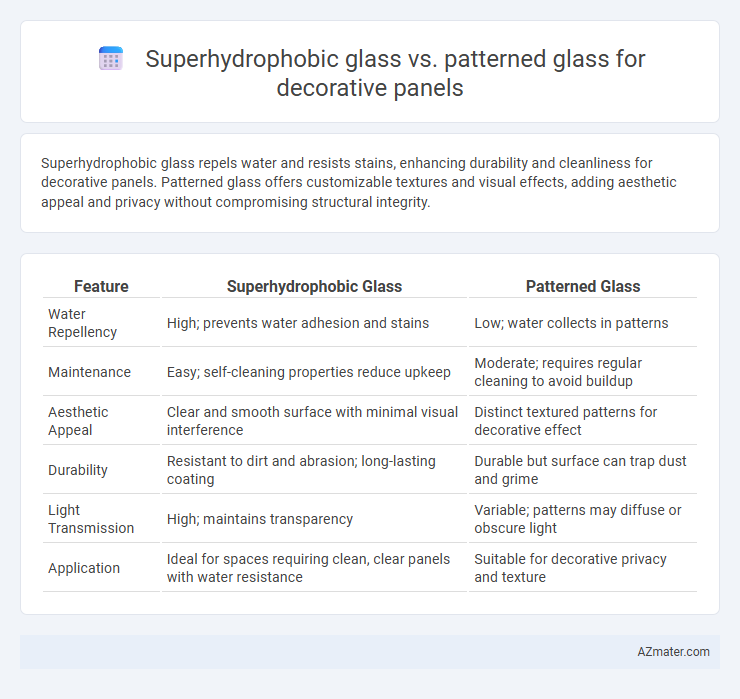Superhydrophobic glass repels water and resists stains, enhancing durability and cleanliness for decorative panels. Patterned glass offers customizable textures and visual effects, adding aesthetic appeal and privacy without compromising structural integrity.
Table of Comparison
| Feature | Superhydrophobic Glass | Patterned Glass |
|---|---|---|
| Water Repellency | High; prevents water adhesion and stains | Low; water collects in patterns |
| Maintenance | Easy; self-cleaning properties reduce upkeep | Moderate; requires regular cleaning to avoid buildup |
| Aesthetic Appeal | Clear and smooth surface with minimal visual interference | Distinct textured patterns for decorative effect |
| Durability | Resistant to dirt and abrasion; long-lasting coating | Durable but surface can trap dust and grime |
| Light Transmission | High; maintains transparency | Variable; patterns may diffuse or obscure light |
| Application | Ideal for spaces requiring clean, clear panels with water resistance | Suitable for decorative privacy and texture |
Introduction to Decorative Glass Panels
Decorative glass panels enhance architectural aesthetics by combining functionality with visual appeal, where superhydrophobic glass offers self-cleaning and water-repellent properties ideal for exterior use. Patterned glass provides customizable textures and designs that diffuse light while maintaining privacy, making it suitable for interior applications. Both types improve durability and design flexibility, catering to different environmental and stylistic requirements in decorative paneling.
What is Superhydrophobic Glass?
Superhydrophobic glass features a nano-engineered surface coating that repels water, causing droplets to bead up and roll off effortlessly, preventing water stains and dirt accumulation. This property enhances durability and maintains clarity, making it ideal for decorative panels exposed to moisture or outdoor environments. Unlike patterned glass, which relies on textured designs for aesthetics, superhydrophobic glass combines functional water resistance with a sleek, smooth appearance.
Understanding Patterned Glass
Patterned glass features textured surfaces created through roller embossing or acid etching, offering unique light diffusion and privacy while maintaining transparency for decorative panels. Its intricate designs enhance aesthetic appeal and can control glare without compromising natural illumination, making it ideal for interior applications. Compared to superhydrophobic glass, which primarily prevents water adhesion, patterned glass emphasizes visual texture and functional privacy in architectural decor.
Aesthetic Appeal: Superhydrophobic vs Patterned Glass
Superhydrophobic glass offers a sleek, water-repellent surface that maintains clarity and brilliance by preventing water spots and stains, enhancing its modern and clean aesthetic appeal. Patterned glass provides textured designs and varied light diffusion, adding depth and decorative complexity ideal for artistic or privacy-focused panels. Choosing between the two depends on whether the preference is for a minimalist, pristine look or a visually intricate, tactile surface.
Durability and Maintenance Comparison
Superhydrophobic glass offers superior durability with its nano-coating that resists water, dirt, and stains, reducing the need for frequent cleaning and maintenance. Patterned glass, while aesthetically versatile, may trap dust and grime in its textures, increasing maintenance efforts over time. The hydrophobic properties of superhydrophobic glass enhance long-term performance by preventing corrosion and surface degradation, making it ideal for exterior decorative panels exposed to harsh environments.
Light Transmission and Privacy Features
Superhydrophobic glass offers high light transmission rates typically above 90%, ensuring clear visibility while repelling water and dirt to maintain clarity and cleanliness. Patterned glass provides enhanced privacy by diffusing light through textured surfaces, reducing transparency but often allowing light transmission between 50-80% depending on the pattern density. Choosing between these depends on the desired balance: superhydrophobic glass prioritizes clarity and maintenance, whereas patterned glass emphasizes privacy with moderate light diffusion.
Cost Analysis: Which Option is More Affordable?
Superhydrophobic glass typically involves higher manufacturing costs due to advanced coating technologies that provide water-repellent and self-cleaning properties, making it a premium choice for decorative panels. Patterned glass, on the other hand, utilizes standard embossing or acid-etching methods, resulting in lower production expenses and more affordable pricing for large-scale projects. For budget-conscious applications, patterned glass generally offers a more cost-effective option without compromising aesthetic appeal.
Application Suitability for Interior Design
Superhydrophobic glass offers exceptional resistance to water and stains, making it ideal for high-moisture interior environments like bathrooms and kitchens where cleanliness and durability are critical. Patterned glass enhances aesthetic appeal through textured or frosted designs, providing privacy and decorative interest suitable for offices, partitions, and living spaces. Choosing between the two depends on the balance between functional durability and visual design requirements in interior decorative panel applications.
Environmental Impact and Sustainability
Superhydrophobic glass features a water-repellent coating that reduces the need for frequent cleaning, lowering water and chemical usage and minimizing environmental pollution. Patterned glass, while enhancing aesthetics and privacy, often requires more energy-intensive manufacturing processes and may lack eco-friendly coatings, impacting its sustainability profile. Selecting superhydrophobic glass for decorative panels supports sustainable building practices by promoting durability, reducing maintenance resources, and improving the overall environmental footprint.
Choosing the Right Decorative Glass Panel
Superhydrophobic glass offers advanced water and stain resistance, making it ideal for decorative panels in humid or outdoor environments where cleanliness and durability are priorities. Patterned glass provides versatile aesthetic options with etched or embossed designs that enhance visual appeal and diffuse light effectively for indoor decorative purposes. Selecting the right decorative glass panel depends on balancing functional needs like maintenance and environmental exposure with design preferences and light transmission requirements.

Infographic: Superhydrophobic glass vs Patterned glass for Decorative panel
 azmater.com
azmater.com